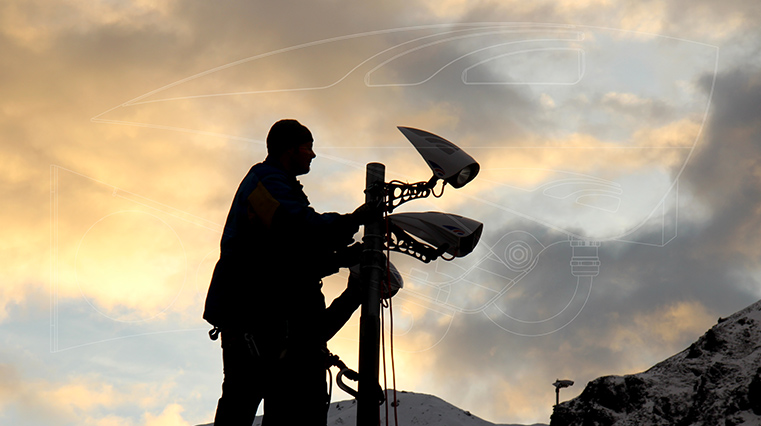Characteristics & benefits of the Arctic Beam

Energy saving
The Arctic Beam produces 31.000 lumens at a power consumption of 280 Watt. With more than 110 lumen per Watt the Arctic Beam is more efficient than gas discharge lamps such as high pressure sodium and metal halide lamps. Depending on the slope characteristics and desired light levels, the Arctic Beam reduces energy costs by up to 50%.
Remotely dimmable
The Arctic Beam Remote Lighting Control System enables ski operators to monitor, switch and dim Arctic Beams individually or in groups. The control system is easy to install, deploy, operate and maintain. The system was specifically tested in misty conditions and hilly surroundings.The Arctic Beam Remote Lighting Control System software can be accessed through a web browser that supports Microsoft Silverlight on a Windows or Mac computer, and through any tablet, Ipad or smartphone with the use of the Slope Lighting Solutions app. With the remote Lighting Control System and a smart phone at their disposal ski slope operators can create a lighting experience that is unprecedented on ski slopes.
Higher effective illumination
The Arctic Beam generates more useful lumens to the eye than other lamps. The reason is that the human eye is more sensitive to the wavelengths emitted by the Arctic Beam than to the wavelengths emitted by gas discharge lamps.
There are two light sensitive components in the retina of the eye, rods and cones. Rods give us our night vision capability (scotopic) vision, while cones give us our daylight (photopic) vision. The chart shows clearly that thelight emitted by the Arctic Beam falls within the scotopic sensitivity of the eye – most of the light emitted by gas discharge lamps (SONT(t) spectrum) falls outside of the scotopic sensitivity.
The ratio of scotopic luminance (or lumens) versus photopic luminance in a lamp is called the S/P ratio, which is a multiplier that determines the apparent visual brightness of a light source as well as how much light a lamp emits that is useful to the human eye, referred to as visually effective lumens (VELs). So to get the visually effective lumens of a light source we need to multiply its specifi ed lumens with the multiplier for that light source. The S/P ratio for LED is 2,1, for low pressure sodium 0,38, for high pressure sodium 0,58 and for HID metal halide 1,49. A higher S/P ratio provides higher visual brightness and sharper vision.
Long lifetime
The calculated lifetime of the LED’s used in the Arctic Beam is very long: after 50.000 hours of usage the Arctic Beam still emits 80% of its original light output and 70% of its original light output after 68.000 hours. If the Arctic Beam is operated at lower power and/or frequently dimmed its lifetime increases even further while maintaining 70% of original light output. As such, replacement costs are considerably lower when compared to gas discharge Lamps that generally last less than 20.000 hours and at which time they have lost at least 25% of their initial light output.


REDUCED LIGHT POLLUTION
The Arctic Beam contributes signifi cantly towards reducing light pollution. In contrast with gas discharge lamps that emit their light in a broad angle and that shine 360° round, leaving light trapped within the armature, LED’s are a directional light source that always emit forward in a 120° angle. This allows us to focus the light where it is really needed, hence making more efficiently use of the light output and thereby reducing light pollution. By employing reflectors with beam angles of 36°, 46° and 60° the Arctic Beam is capable of concentrating the light even further.
REDUCED WHITEOUT EFFECT
Whiteout is a weather condition in which visibility and contrast are severely reduced during snowfall. The horizon disappears completely and there are no reference points at all, leaving the skier with a distorted orientation. The Arctic Beam, through its directional beam, penetrates through whiteout much better than the diffuse light of gas discharge lamps, and so contributes to better visibility and safer skiing.
.jpg)
CONVENTIONAL VERSUS ARCTIC BEAM LED
Left: Conventional lighting.
Note the spill light on the left of the slope.
Right: Slope illuminated with Arctic beams.
Note the absence of spill light and the high
brightness of the Arctic Beams.
NO TOXIC ELEMENTS
The Arctic Beam contains no hazardous chemicals as opposed to Gas discharge lamps that contain mercury which is toxic when released into the environment. To dispose of mercury requires special care and precautions.
BETTER COLOUR APPEARANCE
With a minimum colour rendering index (CRI) of 70, the Arctic Beam makes colourful ski outfits and gear appear natural on the slope. Gas discharge lamps - with the exception of metal halide lamps – have a very poor CRI which causes objects to lose their natural colour and brightness.
DIFFERENT COLOUR TEMPERATURES
The Arctic Beam has two standard Colour Temperatures: 4000K and 6000K. 6000K is preferred because of higher efficiency and higher brightness and visibility. However there is scientific evidence that bright light with a colour temperature well above 4000K can have negative effects on animal nightlife, such as disturbed rest periods, disorientation and a restricted radius of action. This is why in some countries and areas guidelines and laws have been formulated that restrict the colour temperature of luminaires for nighttime illumination to 4000K or lower.
INSTANT ON-OFF
Warm-up and restrike times are absent with the Arctic Beam. Gas discharge lamps require a period of 1 to 15 minutes to reach 90% of their full light output. Additionally, when shut down these lamps need a cool down period before they can restart. This period of time is called the restrike time and can take 20 minutes or even longer.
FORM FACTOR
The Arctic Beam is easy to handle because of its low weight and compact size compared to traditional luminaires. Transport and installation are cost effective.
OPTICAL FLEXIBILITY
Depending on light level requirements the Arctic Beam is available with different beam angles (36°,46°,60°).





